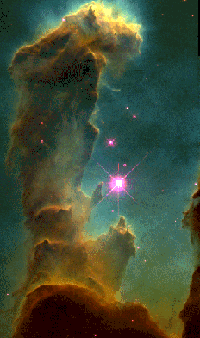The interstellar space between stars is not empty. It contains large amounts of gas and dust particles. These particles swirl around in space, and just like the dust in your house, they are not evenly distributed. We have all found dust bunnies under the furniture in the corners. The same thing happens in space as these particles accumulate into molecular clouds.
Molecular clouds are mix of atoms, molecules, and dust. Atoms are the small building blocks of all the stuff around us. Molecules consist of two or more atoms joined together. The molecules present in molecular clouds are typically molecular hydrogen, H2 , but can also be more complex molecules, such as methanol, which consists of six atoms, or water, which consists of three atoms. Dust grains are even larger clumps of matter and they can be up to a few millimeters in size, which is huge compared with atoms or molecules.
These clouds of dust are scattered across most galaxies. As they grow in size, they become known as nebula. One of the best known is the Orion Nebula.
Turbulence deep within these clouds gives rise to knots with sufficient mass that the gas and dust can begin to collapse under its own gravitational attraction. As the cloud collapses, the material at the center begins to heat up. Known as a protostar, it is this hot core at the heart of the collapsing cloud that will one day become a star.
Stars are fueled by the nuclear fusion of hydrogen to form helium deep in their interiors. The outflow of energy from the central regions of the star provides the pressure necessary to keep the star from collapsing under its own weight, and the energy by which it shines. After millions of years of collapsing and heating, a protostar stabilizes into an adult star. Stars the size of the Sun take 50 million years from beginning of collapse to adulthood.
Sometimes nebula collapse into two stars, called double stars. These stars can share material or even merge into one big star. These big stars may overheat and explode in a supernova, leaving nothing behind. Stellar evolution is a circle of life — dying stars spew their contents into the galaxy, paving the way for the next generation.



